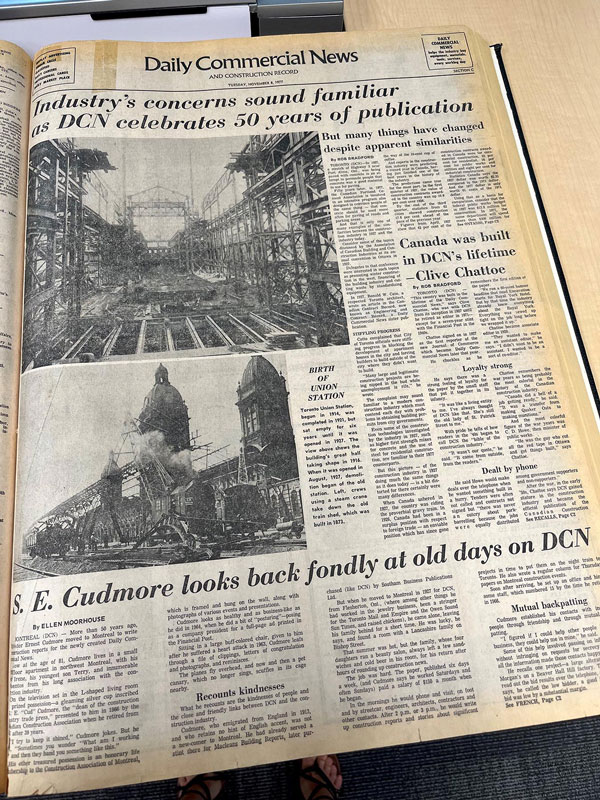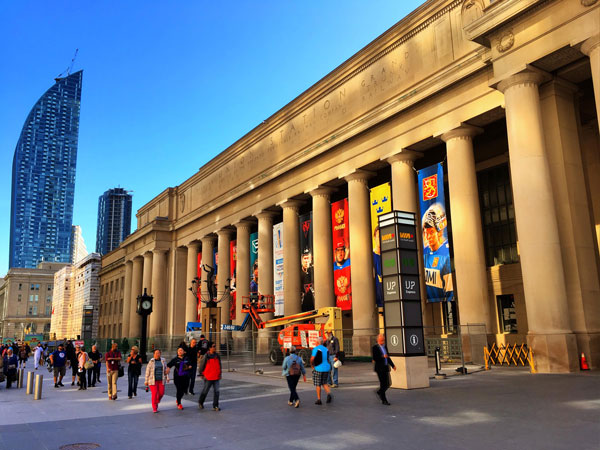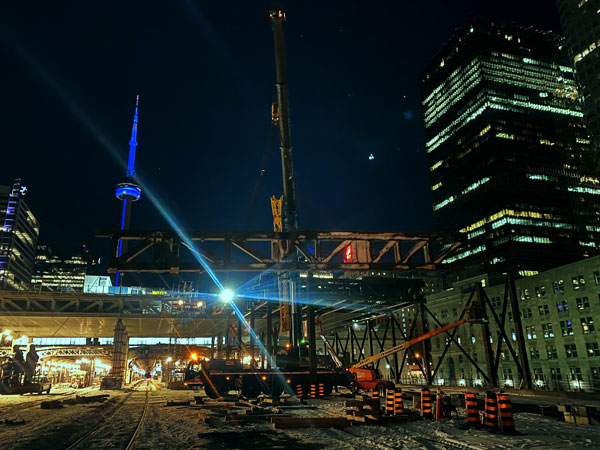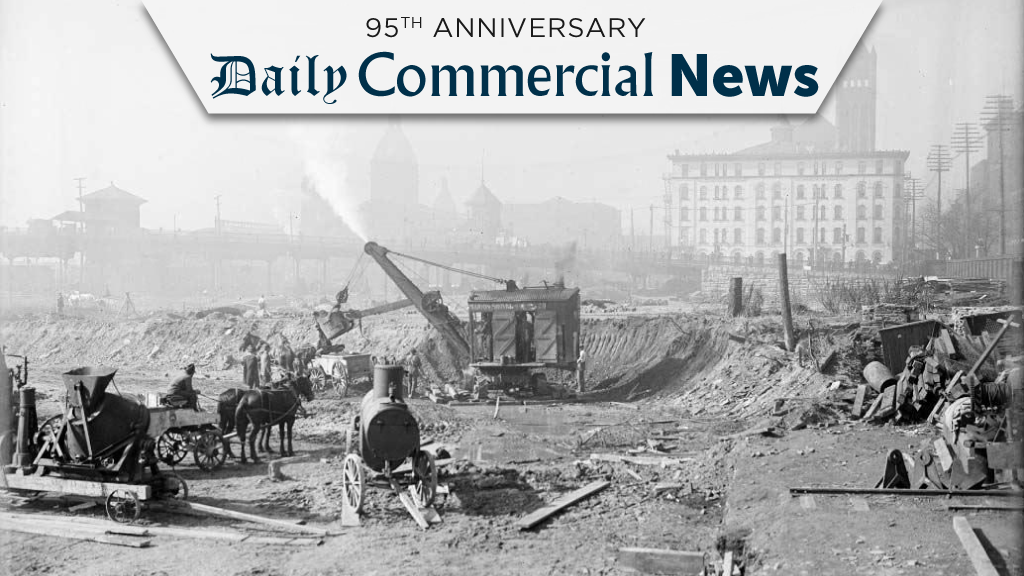The Daily Commercial News (DCN) will celebrate its 95th anniversary on Nov. 8. In the lead up to this milestone, the team has created some special features that originated directly from the archives, as the history of construction in şÚÁĎłÔšĎÍř was captured on those newsprint pages.
The year was 1927.
şÚÁĎłÔšĎÍřâs Old Age Pensions Act was introduced, Charles Lindbergh flew The Spirit of St. Louis nonstop across the Atlantic, The Jazz Singer opened to mark the end of the silent film era, the first edition of the Daily Commercial News was published â and Torontoâs Union Station opened its doors, with Edward, the Prince of Wales, cutting a ribbon with gold scissors. The date: Aug. 6.
âYou build your stations like we build our cathedrals,â Edward exclaimed. âIsnât it grand?â
Done with the scissors, he walked over to the ticket counter and bought the first ticket sold, paying $71.20 for a fare to Alberta.
In the 95 years since, Union Station has been the beating heart of Toronto, processing 300,000 commuters a day in recent times, opening its arms to new Canadians, shipping out soldiers, welcoming war brides, serving as a backdrop for feature films (Silver Streak) and beckoning Canadians from across the land to visit şÚÁĎłÔšĎÍřâs largest city.
âIn addition to its role as a massive and critically important transportation hub that is central to life in the GTA and far beyond, Union Station over 100 years has provided millions of jobs to the construction industry,â observed Council of Ontario Construction Associations president Ian Cunningham, noting expansions, maintenance, modernization and redevelopment.Ěý

âIt has been almost like a living organism, constantly adaptingĚýto service the ever-changing ways of life in Ontario.â
Chris Glover, MPP for Spadina-Fort York, who nominated Union Station as part of the Ontario Association of Architectsâ Queenâs Park Picks competition, picked up on the cathedral metaphor. He remembers entering the Great Hall for the first time as a youth after taking a train from Oshawa.
The names of Canadian cities chiselled into the north wall up on high connect the country, he now realizes.
âIt is a cathedral for transportation, said Glover. âThereâs a book called A Sense of Space that talks about how large spaces have a calming effect on people. Even the way the sound echoes in there.â
âNormal spaces without the normal high ceiling do not have that same sense of grandeur and calmness that the Great Hall does.
âItâs just such a magical place to be, so grand and beautiful.â
Ěý
Great Fire sparks opportunity
Union Station, however, emerged out of conflict and catastrophe.
Torontoâs Great Fire of 1904 razed most of the buildings east of the original train station but prompted planning for a larger facility.
Canadian Pacific and Grand Trunk formed Toronto Terminals Railway to run a new station, notable architects Ross and Macdonald, Hugh G. Jones and John M. Lyle were enlisted to design it and construction began in 1914 â but disagreements and material shortages caused by the First World War delayed completion of the station proper until 1920.
Then would-be passengers sat and waited as stakeholders battled over yard facilities, track layout and grade separations.
A DCN 50th anniversary edition from 1977 summed up the squabble: âFor the next few years, railway officials, city fathers and federal government bigwigs kept passing the buck as to who would build the all-important railway corridor to serve the new Union Station.â
An agreement was reached in 1924 and partial station operations were able to commence in 1927, but the new station was only fully operational in 1931.
Ěý
Beaux-Arts âmonumentalityâ
The Parks şÚÁĎłÔšĎÍř website hosts a report originally written in 1975 that documents the case for Union Station as a National Historic Site.
Union Station was built as an expression of the City Beautiful movement at the turn of the century and beyond. The facility is the largest and most ornate of şÚÁĎłÔšĎÍřâs grand railway stations, an example of Beaux-Arts architecture, the early 1900s architectural style of choice for grand civic buildings. The style borrows from Greek and Roman architecture and is characterized by its monumentality and use of classical ornamentation as well as its symmetry.

At the time of construction, Front Street was widened and the station set back by 70 feet to ensure its scale could be fully appreciated, the Queenâs Park Picks submission notes.
The headhouse is fronted by a five-storey-tall grand colonnade of 18 Doric columns. A pair of identical wings provides space for offices and maintains the symmetry of the structure.
âInspired by the Roman Baths of Caracalla, the Hall is a vast open multi-storey space decorated in restrained classical language and topped with a beautiful ceiling of coffered Guastavino tiles. Continuing the Beaux-Art emphasis on sequence of spaces, centrally placed Corinthian columns on the south side of the room clearly indicate the entrance to the train platforms just beyond,â stated Gloverâs submission.
Other features include Tennessee marble floors, walls faced with Zumbro stone and giant arched windows based on the Roman baths.
Today Union Station is owned by the City of Toronto, which is responsible for most of the renovations, with Metrolinx working on the track corridors.
Glover said he is pleased to see that renovations that have taken place in the 1970s and since 2010 have maintained the splendour of the facility while increasing itâs functionality, âmaking it that much more practical for the hundreds of thousands of people who go through every day.â

Included in the work is an entire new underground floor with food, retail and other services, as well as replacement of the central portion of the train shed with a new glass canopy. Train capacity is being expanded and Metrolinx will be introducing GO electrification.
âOne of the reasons I nominated Union Station is because too often we walk through spaces without pausing to stare and look at the beauty of them,â Glover said. âIâm hoping the nomination will cause some people to stop and appreciate the incredible beauty of Union Station.â
Follow the author on Twitter .




Recent Comments
comments for this post are closed